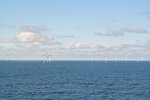11/11/2004
New questions arise with regard to wind turbine safety
The managers of three small airports on Nantucket Sound have raised new questions about wind turbine safety in light of a British government study that found that wind farms wreak havoc with civilian and military radar systems. In letters sent to the Federal Aviation Administration at the end of October, the managers of the Nantucket Memorial Airport, Martha's Vineyard Airport, and Barnstable Municipal Airport asked the agency to reconsider its clearance of the airspace over the 25-square-mile site. In the letters they cite information from a 2002 United Kingdom Ministry of Defense report that states that wind turbines cause interference on radar screens. ''It is possible that aviators and radar operators could work safely with one or perhaps two turbines," the report reads. ''Of greater concern is the prospect of a proliferation of turbines, which could potentially saturate an airfield picture, making safe flying operations difficult to guarantee."
In his letter to the FAA, Quincy Mosby, the airport manager in Barnstable, wrote that he spoke with the Ministry of Defense and was concerned that the proposed project could ''have adverse affects on aviation safety and various air traffic control and defense radar facilities located throughout southern Massachusetts." Both Otis Air National Guard Base and an Air Force radar installation are within 20 miles of the proposed wind farm location. The FAA has previously found no radar problems with the turbines. A 2003 FAA study of the airspace said the turbines would ''not have an adverse effect on physical, electromagnetic, or line of sight interference or existing or proposed air navigation, communications, radar, [and] control system facilities."
A separate report by the Army Corps of Engineers released earlier this month predicted little environmental damage from the proposed wind farm. Engineers for Cape Wind Associates, the group proposing the wind farm, said the concerns the UK has experienced are unique and have to do with its choice of sites. "The FAA, in their scope of work in their aeronautical study, looked at radar, and it's black and white," said Leonard Fagan, the vice president of engineering for Cape Wind Associates. "Our site does not have a problem". Fagan said that the UK defense ministry only found problems on "a couple" of sites and those problems deal in part with the way the British use radar in air defense.
In his letter to the FAA, Quincy Mosby, the airport manager in Barnstable, wrote that he spoke with the Ministry of Defense and was concerned that the proposed project could ''have adverse affects on aviation safety and various air traffic control and defense radar facilities located throughout southern Massachusetts." Both Otis Air National Guard Base and an Air Force radar installation are within 20 miles of the proposed wind farm location. The FAA has previously found no radar problems with the turbines. A 2003 FAA study of the airspace said the turbines would ''not have an adverse effect on physical, electromagnetic, or line of sight interference or existing or proposed air navigation, communications, radar, [and] control system facilities."
A separate report by the Army Corps of Engineers released earlier this month predicted little environmental damage from the proposed wind farm. Engineers for Cape Wind Associates, the group proposing the wind farm, said the concerns the UK has experienced are unique and have to do with its choice of sites. "The FAA, in their scope of work in their aeronautical study, looked at radar, and it's black and white," said Leonard Fagan, the vice president of engineering for Cape Wind Associates. "Our site does not have a problem". Fagan said that the UK defense ministry only found problems on "a couple" of sites and those problems deal in part with the way the British use radar in air defense.
- Source:
- Online editorial www.windfair.net
- Author:
- Trevor Sievert, Online Editorial Journalist
- Email:
- press@windfair.net
- Keywords:
- wind energy, wind turbine, wind farm, renewable energy, onshore, offshore

























